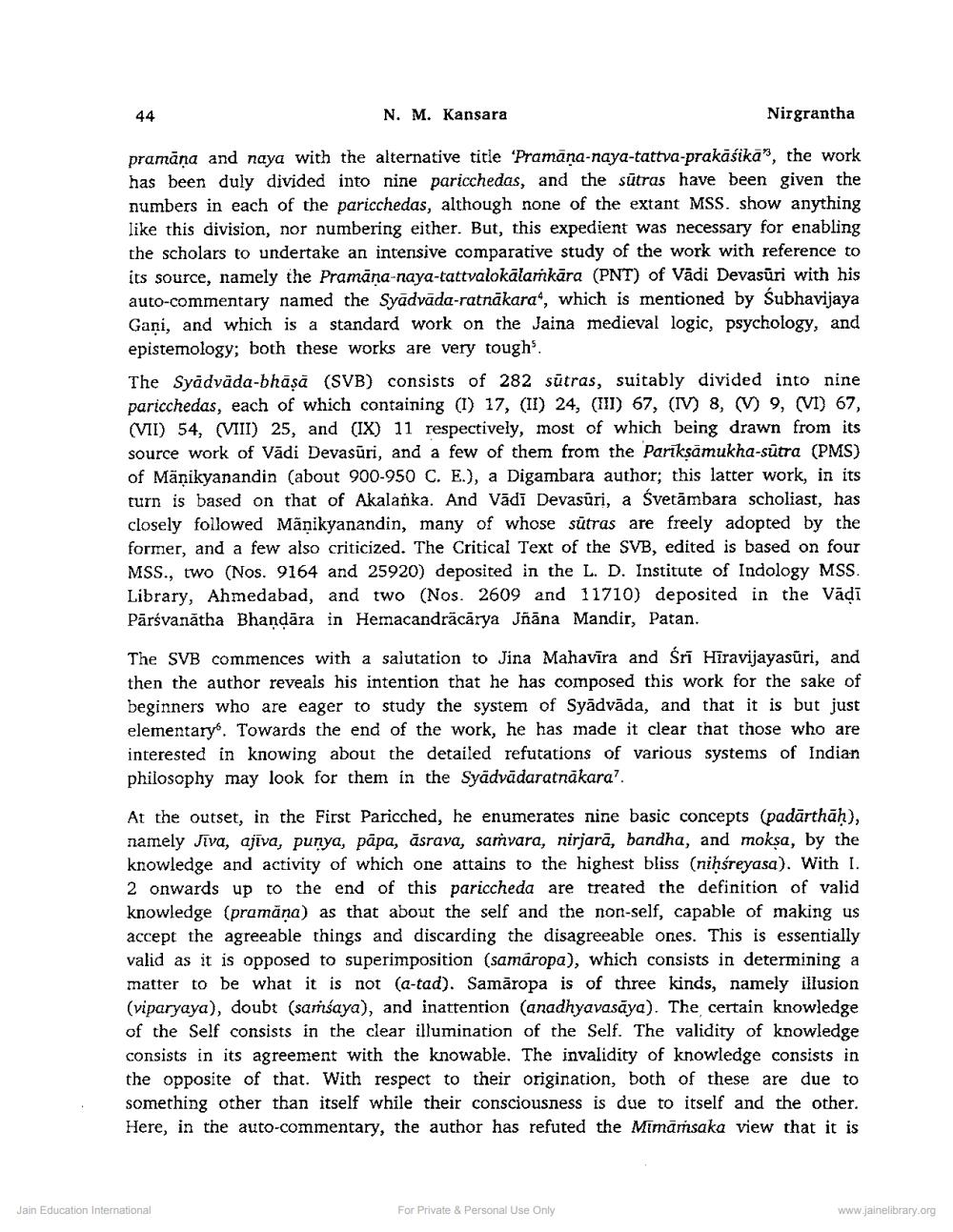Book Title: Syadvadbhasa of Shubhvijay Gani Author(s): N M Kansara Publisher: Z_Nirgrantha_1_022701.pdf and Nirgrantha_2_022702.pdf and Nirgrantha_3_022703.pdf View full book textPage 2
________________ 44 N. M. Kansara Nirgrantha pramana and naya with the alternative title 'Pramāna-naya-tattva-prakäsika", the work has been duly divided into nine paricchedas, and the sūtras have been given the numbers in each of the paricchedas, although none of the extant MSS. show anything like this division, nor numbering either. But, this expedient was necessary for enabling the scholars to undertake an intensive comparative study of the work with reference to its source, namely the Pramāna-naya-tattvalokālaṁkāra (PNT) of Vadi Devasūri with his auto-commentary named the Syadvada-ratnākara", which is mentioned by Subhavijaya Gani, and which is a standard work on the Jaina medieval logic, psychology, and epistemology; both these works are very tough. The Syādvăda-bhāṣā (SVB) consists of 282 sūtras, suitably divided into nine paricchedas, each of which containing (1) 17, (II) 24, (III) 67, (IV) 8, (V) 9, (VI) 67, (VII) 54, (VIII) 25, and (IX) 11 respectively, most of which being drawn from its source work of Vādi Devasūri, and a few of them from the Parīksamukha-sūtra (PMS) of Mänikyanandin (about 900-950 C. E.), a Digambara author; this latter work, in its turn is based on that of Akalańka. And Vādi Devasūri, a Svetāmbara scholiast, has closely followed Manikyanandin, many of whose sutras are freely adopted by the former, and a few also criticized. The Critical Text of the SVB, edited is based on four MSS., two (Nos. 9164 and 25920) deposited in the L. D. Institute of Indology MSS. Library, Ahmedabad, and two (Nos. 2609 and 11710) deposited in the Vādī Pārsvanātha Bhandāra in Hemacandrācārya Jñāna Mandir, Patan. The SVB commences with a salutation to Jina Mahavīra and Śrī Hīravijayasūri, and then the author reveals his intention that he has composed this work for the sake of beginners who are eager to study the system of Syādvāda, and that it is but just elementary. Towards the end of the work, he has made it clear that those who are interested in knowing about the detailed refutations of various systems of Indian philosophy may look for them in the Syädvādaratnākara? At the outset, in the First Paricched, he enumerates nine basic concepts (padārthāḥ), namely Jiva, ajīva, punya, pāpa, asrava, samvara, nirjarā, bandha, and moksa, by the knowledge and activity of which one attains to the highest bliss (niņśreyasa). With I. 2 onwards up to the end of this pariccheda are treated the definition of valid knowledge (pramana) as that about the self and the non-self, capable of making us accept the agreeable things and discarding the disagreeable ones. This is essentially valid as it is opposed to superimposition (samáropa), which consists in determining a matter to be what it is not (a-tad). Samāropa is of three kinds, namely illusion (viparyaya), doubt (sambaya), and inattention (anadhyavasāya). The certain knowledge of the Self consists in the clear illumination of the Self. The validity of knowledge consists in its agreement with the knowable. The invalidity of knowledge consists in the opposite of that. With respect to their origination, both of these are due to something other than itself while their consciousness is due to itself and the other. Here, in the auto-commentary, the author has refuted the Mimāṁsaka view that it is Jain Education International For Private & Personal Use Only www.jainelibrary.orgPage Navigation
1 2 3 4 5 6 7 8
